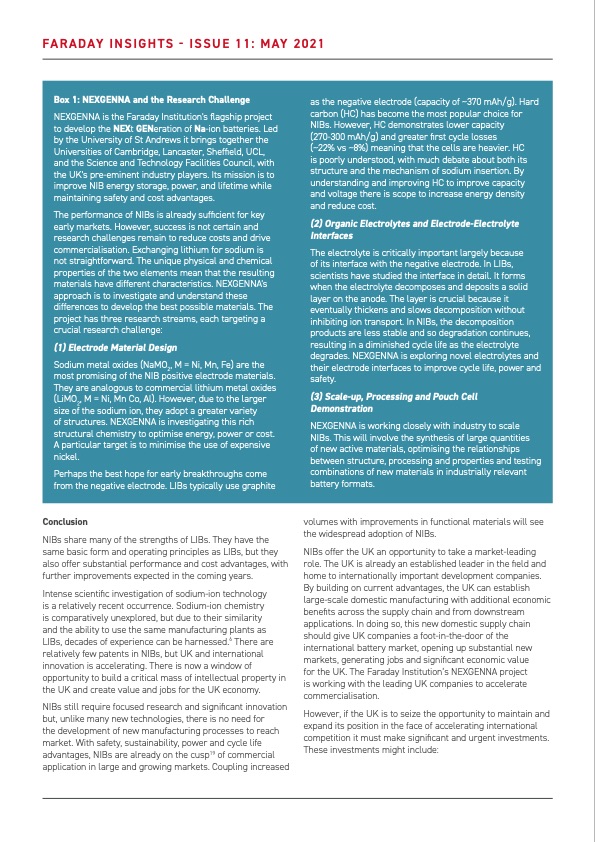
PDF Publication Title:
Text from PDF Page: 005
FARADAY INSIGHTS - ISSUE 11: MAY 2021 Box 1: NEXGENNA and the Research Challenge NEXGENNA is the Faraday Institution's flagship project to develop the NEXt GENeration of Na-ion batteries. Led by the University of St Andrews it brings together the Universities of Cambridge, Lancaster, Sheffield, UCL, and the Science and Technology Facilities Council, with the UK's pre-eminent industry players. Its mission is to improve NIB energy storage, power, and lifetime while maintaining safety and cost advantages. The performance of NIBs is already sufficient for key early markets. However, success is not certain and research challenges remain to reduce costs and drive commercialisation. Exchanging lithium for sodium is not straightforward. The unique physical and chemical properties of the two elements mean that the resulting materials have different characteristics. NEXGENNA's approach is to investigate and understand these differences to develop the best possible materials. The project has three research streams, each targeting a crucial research challenge: (1) Electrode Material Design as the negative electrode (capacity of ~370 mAh/g). Hard carbon (HC) has become the most popular choice for NIBs. However, HC demonstrates lower capacity (270-300 mAh/g) and greater first cycle losses (~22% vs ~8%) meaning that the cells are heavier. HC is poorly understood, with much debate about both its structure and the mechanism of sodium insertion. By understanding and improving HC to improve capacity and voltage there is scope to increase energy density and reduce cost. (2) Organic Electrolytes and Electrode-Electrolyte Interfaces The electrolyte is critically important largely because of its interface with the negative electrode. In LIBs, scientists have studied the interface in detail. It forms when the electrolyte decomposes and deposits a solid layer on the anode. The layer is crucial because it eventually thickens and slows decomposition without inhibiting ion transport. In NIBs, the decomposition products are less stable and so degradation continues, resulting in a diminished cycle life as the electrolyte degrades. NEXGENNA is exploring novel electrolytes and their electrode interfaces to improve cycle life, power and safety. (3) Scale-up, Processing and Pouch Cell Demonstration NEXGENNA is working closely with industry to scale NIBs. This will involve the synthesis of large quantities of new active materials, optimising the relationships between structure, processing and properties and testing combinations of new materials in industrially relevant battery formats. Sodium metal oxides (NaMO , M = Ni, Mn, Fe) are the 2 most promising of the NIB positive electrode materials. They are analogous to commercial lithium metal oxides (LiMO2, M = Ni, Mn Co, Al). However, due to the larger size of the sodium ion, they adopt a greater variety of structures. NEXGENNA is investigating this rich structural chemistry to optimise energy, power or cost. A particular target is to minimise the use of expensive nickel. Perhaps the best hope for early breakthroughs come from the negative electrode. LIBs typically use graphite Conclusion NIBs share many of the strengths of LIBs. They have the same basic form and operating principles as LIBs, but they also offer substantial performance and cost advantages, with further improvements expected in the coming years. Intense scientific investigation of sodium-ion technology is a relatively recent occurrence. Sodium-ion chemistry is comparatively unexplored, but due to their similarity and the ability to use the same manufacturing plants as LIBs, decades of experience can be harnessed.6 There are relatively few patents in NIBs, but UK and international innovation is accelerating. There is now a window of opportunity to build a critical mass of intellectual property in the UK and create value and jobs for the UK economy. NIBs still require focused research and significant innovation but, unlike many new technologies, there is no need for the development of new manufacturing processes to reach market. With safety, sustainability, power and cycle life advantages, NIBs are already on the cusp19 of commercial application in large and growing markets. Coupling increased volumes with improvements in functional materials will see the widespread adoption of NIBs. NIBs offer the UK an opportunity to take a market-leading role. The UK is already an established leader in the field and home to internationally important development companies. By building on current advantages, the UK can establish large-scale domestic manufacturing with additional economic benefits across the supply chain and from downstream applications. In doing so, this new domestic supply chain should give UK companies a foot-in-the-door of the international battery market, opening up substantial new markets, generating jobs and significant economic value for the UK. The Faraday Institution’s NEXGENNA project is working with the leading UK companies to accelerate commercialisation. However, if the UK is to seize the opportunity to maintain and expand its position in the face of accelerating international competition it must make significant and urgent investments. These investments might include:PDF Image | Sodium-ion Batteries: Inexpensive and Sustainable Storage

PDF Search Title:
Sodium-ion Batteries: Inexpensive and Sustainable StorageOriginal File Name Searched:
Faraday_Insights_11_FINAL.pdfDIY PDF Search: Google It | Yahoo | Bing
Salgenx Redox Flow Battery Technology: Salt water flow battery technology with low cost and great energy density that can be used for power storage and thermal storage. Let us de-risk your production using our license. Our aqueous flow battery is less cost than Tesla Megapack and available faster. Redox flow battery. No membrane needed like with Vanadium, or Bromine. Salgenx flow battery
| CONTACT TEL: 608-238-6001 Email: greg@salgenx.com | RSS | AMP |